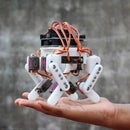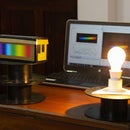Introduction: 3D Printed Hex Bit Holder
Over the years I have gathered a variety of hex bits, some inherited from my father's toolbox and other that came with miscellaneous new tools. The once half empty container of hex bits soon filled up leading to countless minutes rummaging for the desired bit. I finally decided to make a holder to neaten things up.
Although this bit storage system can easily be made out of wood I chose to use 3d printing for the convenience and for the ease to make customisable holder/decluttering accessories.
Do drop a vote to support this project in the "Declutter Contest"
Step 1: Decluttering and Designing Process
One of the main aims is to make the holder as compact as possible. To start with I emptied out the container of hex bits and made divided the random mess, into batches of the same type. In the end there were four variants : the common slotted bits (flathead), Phillips bits (cross), Torx bits (star) and the internal hex bits (hexagon). Once done I further made another division in terms of the lengths, standard and long ones. This gave me a rough idea that the holder would have five rows, each consisting of one category, the long bits being one set. The maximum type of bits of a certain set were that of the Phillips drivers which was 12 and thus that determined the number of columns needed. I added three more columns in the design to give some flexibility to future bits. Finally measure the hexagon, from side to side, and we have all the dimensions required for modelling.
Step 2: Modelling the Holder Using Fusion 360
With all the details from the previous step I modelled the holder using Fusion 360, which is a great CAD softwares for beginners to get started and is free for students. I kept 6mm of spacing between each hex slot to easily be able to pick the individual bit. I created a sketch and with the help of the rectangular pattern I made the layout of the rows and columns. I made slots of depth 5mm for the standard length bits and for the longer ones 10mm. Once done I extruded the various sketches to form the solid shape and added fillets to round the hard edges.
Step 3: 3D Printing and Testing
I printed the model which just about fit on my Ender 3d printer. The holder was printed in PLA at a 10% infill as this print won't be bearing any load. The STL file can be found attached below free for one to customise!
The bits should fit well and are held snuggly. Fill up the slots with the various bits, I arranged them by category so that they are quick to locate.
Attachments
Step 4: Before and After
Bringing order and decluttering a space brings satisfaction and as this project shows it can be pretty simple most of the times. This holder was a small change to the workspace but it has had a big impact on my workflow. Hope this was helpful and inspires you to make your own.
Happy Making!

Second Prize in the
Declutter Speed Challenge














